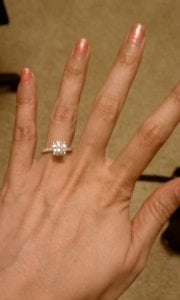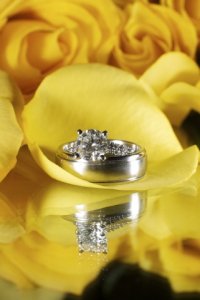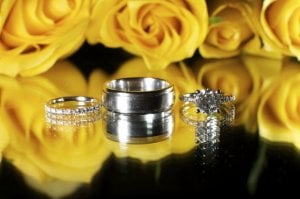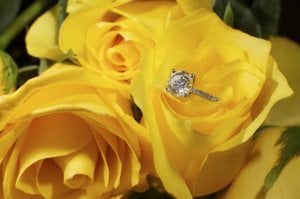serinatran
Rough_Rock
- Joined
- Feb 1, 2012
- Messages
- 10
So I was a major lurker on these boards and learned a whole lot of things from all the helpful people on here. Now it's my turn to share with y'all pics of my engagement ring from my wonderful fiance! It's a 1.5 carat round brillant cut, H color, GIA excellent, eyeclean SI2. The setting is the thin french cut pave platinum band from James Allen.
Here's a couple of things that I learned after I got this ring that I think would be helpful to those still shopping.
1. There is nothing like actually seeing the diamond. No amount of HCA scores or clarity plot graphs or ASET image or Idealscope image will tell you how a diamond will perform in person although they will give you a pretty good idea. So if you can afford the slight extra markup of dealing with a local jeweler that is the best way to automatically screen out a diamond that doesn't "sparkle" like crazy. However, online is where you will get the best deals so if you don't mind taking the time and hassle of possibly sending back a diamond then it's the best bang for your buck. My fiance had to return two diamonds before he ended up with the one he proposed with. So if you do buy online, make sure to buy from a vendor with an excellent return policy.
2. Try to find the lowest clarity diamond that is still eyeclean. This will give you the best bang for your buck. It is extremely rare to find an eyeclean SI2 but they do exist! Of course everyone's definition of eye clean is different but I was so surprised by how eyeclean my diamond is. I could barely find the inclusions even under a loupe with a clarity plot. They are a little more apparent from the side but even then I have to tilt it a certain way and look at it at closeup at a few inches to see them. The thing to look for is to find something with a lot of little inclusions spread out. Try to find something where the major inclusion is twinning wisps. As long as they are spread out, even if the inclusion plot looks scary if they are small enough they will still be eyeclean. Remember that most diamonds are viewed from the top at a distance of 6 inches or more. The main inclusion you will want to avoid is a black carbon spot in the middle of the table which is really obvious and visible to the eye. I like James Allen because they have pictures of the diamond... I would not risk buying online without at least a picture. It really does help to screen out the ones that might not be eyeclean. Sometimes, when looking at the online pictures because they are blown up so much it might seem as though certain inclusions are obvious but just look at the smaller picture not blown up to get an idea if you might see the inclusions are not.
3. The most important determining factor for brilliance and fire is the cut. Make sure you find the best cut diamond. Of course not all GIA excellent cuts are the same! That's why it's important to actually see the diamond. A well cut diamond will also help to hide any inclusions. The HCA tool is a good predictor of cut in addition to the GIA or AGS ratings.
4. My diamond had a medium blue flourescence. It really helps to make the diamond look whiter in most lighting conditions. However, I wish I had known that in direct sunlight you can actually see a slight bluish tint. If you are sensitive to color, I would not go lower than H in color. I think my diamond is extremely white faceup in the platinum setting however from the side if you look very carefully, you can start to see a hint of color.
Here are some things I wish I had known about the thin french cut pave platinum setting from James Allen. It was one of the more inexpensive pave settings that I could find. However there weren't many reviews from people that had actually purchased this setting when I was looking online.
1. This is not technically true pave setting. Each diamond has four prongs to hold it instead of shared prongs. I actually like this better though as it feels like the diamond stones are more securely set with 4 individual prongs. I was worried a lot about stones falling out of a pave setting but no issues so far.
2. This setting will not sit flush with the matching diamond wedding band. I wish I had known this before I purchased. I'm not sure if it's because the center stone is a bit too large but the prongs extend out from the band so it will not sit flush. Now I have to decide if I want to get a curved band that will sit flush or a straight band that will have a gap. It might be better to get the regular french cut pave setting as that is a little thicker (2.1mm instead of 1.6-1.7mm) so perhaps the prongs might not extend out with a larger center stone. However, I do love the way this setting looks by itself as the center stone POPS out against the very thin band. I've had a lot of people comment that it looks bigger than 1.5 carats for this reason. Because the band is so thin though I definitely recommend getting this setting only if you have very small fingers. I am a size 3.25.
3. If you get a big center stone on a thin band, be prepared for it to twist a lot! I have to get the ring a little bit bigger so that it fits over my knuckle and in case my hand swells in hot weather so it is a bit loose. But because of the heavy weight of the big center stone, I find that I am constantly having to readjust it because it twists and the center diamond is not centered on my finger. It is a bit annoying but I still love the way the proportion of the center diamond looks in relation to the band so I am willing to deal with it but it's definitely something you should consider if you are thinking about getting a setting like this.
Hope all of this info helps someone else. Sorry for how blurry the picture is from my camera phone. I will try and take a better pic later.

Here's a couple of things that I learned after I got this ring that I think would be helpful to those still shopping.
1. There is nothing like actually seeing the diamond. No amount of HCA scores or clarity plot graphs or ASET image or Idealscope image will tell you how a diamond will perform in person although they will give you a pretty good idea. So if you can afford the slight extra markup of dealing with a local jeweler that is the best way to automatically screen out a diamond that doesn't "sparkle" like crazy. However, online is where you will get the best deals so if you don't mind taking the time and hassle of possibly sending back a diamond then it's the best bang for your buck. My fiance had to return two diamonds before he ended up with the one he proposed with. So if you do buy online, make sure to buy from a vendor with an excellent return policy.
2. Try to find the lowest clarity diamond that is still eyeclean. This will give you the best bang for your buck. It is extremely rare to find an eyeclean SI2 but they do exist! Of course everyone's definition of eye clean is different but I was so surprised by how eyeclean my diamond is. I could barely find the inclusions even under a loupe with a clarity plot. They are a little more apparent from the side but even then I have to tilt it a certain way and look at it at closeup at a few inches to see them. The thing to look for is to find something with a lot of little inclusions spread out. Try to find something where the major inclusion is twinning wisps. As long as they are spread out, even if the inclusion plot looks scary if they are small enough they will still be eyeclean. Remember that most diamonds are viewed from the top at a distance of 6 inches or more. The main inclusion you will want to avoid is a black carbon spot in the middle of the table which is really obvious and visible to the eye. I like James Allen because they have pictures of the diamond... I would not risk buying online without at least a picture. It really does help to screen out the ones that might not be eyeclean. Sometimes, when looking at the online pictures because they are blown up so much it might seem as though certain inclusions are obvious but just look at the smaller picture not blown up to get an idea if you might see the inclusions are not.
3. The most important determining factor for brilliance and fire is the cut. Make sure you find the best cut diamond. Of course not all GIA excellent cuts are the same! That's why it's important to actually see the diamond. A well cut diamond will also help to hide any inclusions. The HCA tool is a good predictor of cut in addition to the GIA or AGS ratings.
4. My diamond had a medium blue flourescence. It really helps to make the diamond look whiter in most lighting conditions. However, I wish I had known that in direct sunlight you can actually see a slight bluish tint. If you are sensitive to color, I would not go lower than H in color. I think my diamond is extremely white faceup in the platinum setting however from the side if you look very carefully, you can start to see a hint of color.
Here are some things I wish I had known about the thin french cut pave platinum setting from James Allen. It was one of the more inexpensive pave settings that I could find. However there weren't many reviews from people that had actually purchased this setting when I was looking online.
1. This is not technically true pave setting. Each diamond has four prongs to hold it instead of shared prongs. I actually like this better though as it feels like the diamond stones are more securely set with 4 individual prongs. I was worried a lot about stones falling out of a pave setting but no issues so far.
2. This setting will not sit flush with the matching diamond wedding band. I wish I had known this before I purchased. I'm not sure if it's because the center stone is a bit too large but the prongs extend out from the band so it will not sit flush. Now I have to decide if I want to get a curved band that will sit flush or a straight band that will have a gap. It might be better to get the regular french cut pave setting as that is a little thicker (2.1mm instead of 1.6-1.7mm) so perhaps the prongs might not extend out with a larger center stone. However, I do love the way this setting looks by itself as the center stone POPS out against the very thin band. I've had a lot of people comment that it looks bigger than 1.5 carats for this reason. Because the band is so thin though I definitely recommend getting this setting only if you have very small fingers. I am a size 3.25.
3. If you get a big center stone on a thin band, be prepared for it to twist a lot! I have to get the ring a little bit bigger so that it fits over my knuckle and in case my hand swells in hot weather so it is a bit loose. But because of the heavy weight of the big center stone, I find that I am constantly having to readjust it because it twists and the center diamond is not centered on my finger. It is a bit annoying but I still love the way the proportion of the center diamond looks in relation to the band so I am willing to deal with it but it's definitely something you should consider if you are thinking about getting a setting like this.
Hope all of this info helps someone else. Sorry for how blurry the picture is from my camera phone. I will try and take a better pic later.








300x240.png)